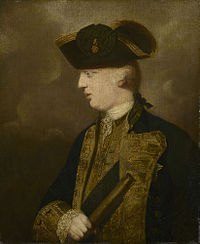Prince Edward, Duke of York and Albany
| Prince Edward | |||||
|---|---|---|---|---|---|
| Duke of York and Albany | |||||
 | |||||
| Burial | 1 November 1767 Westminster Abbey, London | ||||
| |||||
| House | House of Hanover | ||||
| Father | Frederick, Prince of Wales | ||||
| Mother | Princess Augusta of Saxe-Gotha | ||||
Prince Edward, Duke of York (Edward Augustus[1]; 25 March 1739 – 17 September 1767), was the younger brother of George III of the United Kingdom, the second son of Frederick, Prince of Wales and Augusta of Saxe-Gotha.
Early life

The young prince was baptised Edward Augustus, at Norfolk House, by The Bishop of Oxford, Thomas Secker, and his godparents were his great-uncle The King in Prussia (for whom The Duke of Queensberry stood proxy), The Duke of Brunswick-Wolfenbüttel (who was represented by Lord Carnarvon), and his maternal aunt The Duchess of Saxe-Weissenfels (for whom Lady Charlotte Edwin, a daughter of the late 4th Duke of Hamilton, stood proxy).[2]
Seven Years War
Edward showed an interest in naval affairs and sought permission to serve with the Royal Navy. He participated in the naval descents against the French coast taking part in the failed Raid on St Malo, which ended in the Battle of St. Cast in 1758.
Later life

He was created Duke of York and Albany and Earl of Ulster by his paternal grandfather, George II, on 1 April 1760[3].
When Edward's brother ascended the throne on 25 October 1760 as George III, he named Edward a privy counsellor.
From the time his brother became king and until the birth of the king's first child, George, Prince of Wales on 12 August 1762, the duke was heir presumptive to the British throne.
In the late summer of 1767, on his way to Genoa, Edward fell ill and had to be landed in the harbour of Monaco. Despite the care and attention he was given, he died in the Palace of Honoré III, Prince of Monaco, on 17 September. The state bedchamber where the ill duke died has since been known as the York Room. After his death, his body was returned to London aboard HMS Montreal, and is interred in Westminster Abbey.[4]
Legacy

Literature
In 1762, James Boswell published “The Cub at Newmarket”, a poem which he dedicated to Prince Edward, without getting his permission. Boswell met the prince at the Newmarket races in 1760 during his first visit to London. The cub referenced in the work is Boswell himself. The dedication reads:
TO
His ROYAL HIGHNESS
EDWARD
Duke of YORK
Sir,
PERMIT me to take this method of thanking your Royal Highness, for condescending to like the following Sketch. Or, in other Words, permit me to let the World know that this fame Cub has been laughed at by the Duke of YORK;---- has been read to your Royal Highness by the Genius himself, and warmed by the immediate beams of your kind Indulgence.
HAD I been able to conceal this, I should have imagined that I had not the least Spark of the Enthusiasm of Parnassus in my Composition.---- To be so deficient in Vanity, which, if I am not mistaken, may be reckoned an inseparable Characteristic of a Poet.
THIS Trifle, SIR, would not presume to interrupt you, when engaged in matters of Consequence. It only begs leave to pay it's Respects in an hour devoted to cheerful Festivity.
I wish your Royal Highness a long, a merry, and a happy Life; and am,
Your obliged
Devoted Servant.[5]
Places and people named after Prince Edward
- Prince Edward County, Virginia.
- The Cape York Peninsula, located in Far North Queensland, Australia, and Cape York, at the tip of the peninsula, which is the northernmost point on the Australian continent.
- The Duke of York Islands, (formerly Template:Lang-de), are a group of islands located in East New Britain Province, Papua New Guinea. They are found in St George's Channel between New Britain and New Ireland islands and form part of the Bismarck Archipelago.
- Duke of York Island, the largest island of Duke of York Islands, Papua New Guinea.
- Prince Edward Augustus, fourth son of King George III, who was born the day after he was buried at Westminster Abbey.
Titles, styles, honour and arms
Titles and styles
- 25 March 1739–1 April 1760: His Royal Highness Prince Edward[1]
- 1 April 1760–17 September 1767: His Royal Highness The Duke of York and Albany
Arms
Edward was granted use of the arms of the kingdom, differenced by a label argent of five points, the centre bearing a cross gules, the other points each bearing a canton gules.[6]
Ancestors
References
- ^ a b c In the London Gazette, the Prince is called simply 'Prince Edward' (16 November 1756; 28 June 1757; 18 April 1758; 27 October 1759; 1 January; 2 February 1760)
- ^ Yvonne's Royalty Home Page: Royal Christenings
- ^ Yvonne's Royalty: Peerage
- ^ Winfield, Rif (2007). British Warships in the Age of Sail 1793–1817: Design, Construction, Careers and Fates. Seaforth Publishing. p. 190. ISBN 1861762461.
- ^ http://www.jamesboswell.info/literature/cub-newmarket-1762
- ^ Marks of Cadency in the British Royal Family
- 1739 births
- 1767 deaths
- Princes of Great Britain
- Heirs to the British throne
- House of Hanover
- Dukes in the Peerage of Great Britain
- Dukes of York and Albany
- Earls in the Peerage of Ireland
- Earls of Ulster
- Fellows of the Royal Society
- Royal Fellows of the Royal Society
- Burials at Westminster Abbey
- People from Westminster
